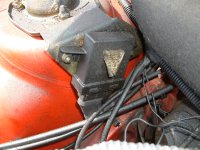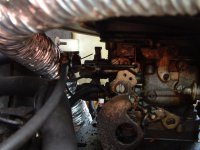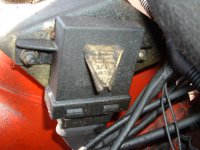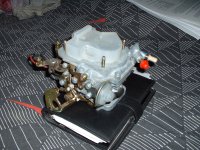Interesting information there, thanks.

The rest of this post is basically like a public-viewable private message

No-one else will be interested other than Chas, so please feel free to skip the rest, it's long and boring

The USA X1/9 from 1981 had (initially as an option, then standard '82-'84, I'm not sure whether the X1/9 was available in the USA after 1984) fuel injection which was multi-point and appears to use the same plenum chamber (the cylinder-shape with the central throttle body) as the much later Uno Turbo. This was the L-Jetronic system and in the X1/9, with catalytic converter and electronic ignition (yes, in 1981) it gave 75bhp (compared with 85bhp for the carburettor X1/9). Pieceing together the puzzle, we can guess that the Uno 75SX did indeed use a similar engine/injection setup to the fuel-injected X1/9, perhaps because of emissions compliance (Sweden) and availability - so you were right after all.
I also wonder why the fuel cut off on my 70 SX is so complicated compared to my previous 45S'? The 45 only had one wire that was live with ignition on and dead with it off. Nice and simple! Still, Fiat works in somewhat strange ways...
Ah - the idea of the fuel-cutoff-on-the-overrun for the 60 and 70 models is that, when going down a hill, or otherwise decelerating with the throttle closed, there is a poor intake of air and yet quite a lot of petrol admitted through the idle jet. Therefore, for reasons of emissions and economy, it makes sense to cut the fuel off - although the fuel must of course be reinstated when the throttle reopens or when the engine reaches idle speed, whichever happens first.
There is a strange situation that arises if the engine is idling too fast - at around the 2000RPM typical cutoff point, or maybe if the throttle switch is mis-set. If the RPM is high and the throttle switch registers as 'closed', the ECU will cut the fuel. The RPM will drop sharply, so the ECU reinstates the fuel. The result is a once-a-second surging effect. The cure is to set the idle speed properly and/or adjust the throttle switch to be 'closed' only when the throttle is actually closed. I struck this on a Tipo but suspect it would apply to the Uno as well.
But again, there is no over-run cutoff the 45 since that only cuts-off when the key goes off. That provision on the 45 could be called an 'anti-dieseling cutoff', since it prevents the engine from running-on - self-igniting from advanced ignition timing. The FIRE runs advanced timing at idle (un-throttled vacuum advance), and fairly high compression, so I suspect that it might otherwise run-on in hot conditions. I guess that, on the 60/70, the over-run fuel cutoff also cuts the fuel when the key goes off...
Fuel injection systems usually include the fuel-cutoff function as part of the injector operation, though you never quite know when the cutoff takes place. I've often wondered whether it's above 2000RPM, for instance, so that coasting along in my Punto may still be using fuel due to the low revs that the CVT allows. Ditto with my 164 which is rather high-geared in the lower ratios, so I wonder whether the fuel would ever be cut-off around town.
I have the solution to these questions lying in my electronics drawer - I have an injector-duty-cycle meter kit - obviously I haven't got around to making it and anyway it would be quicker to hook up the handheld oscilloscope to the injectors and go for a drive

Just in case I haven't said it before, for the record, I think that fuel injection is always superior to a carburettor/twin carburettors for a daily-driver car. Fuel injection ends up being simpler than a carburettor+additions. It's strange that many fuel injection applications (in FIATs) - the X1/9, the Uno, the Tipo - have delivered less power than the carburettor equivalents, but I think the culprit for this lies in other changes to reduce emissions.
If we compare, say, a 1498cc California-spec carburettor 1979 X1/9 (65bhp) with its electronic counterpart (75bhp) then the difference is obvious, but what the figures don't show is the improved driveability (easier starting, smoother idle, better progression/no flat spots, etc.) because a lean-jetted carburettor is a horrid device. That's why I tend to drill the idle jet out slightly on the Uno 45, because it seems to be too small (on some particular examples) to allow for proper idling/progression - the engine just dies when you open the throttle unless the choke is on, and the choke defeats the purpose of having the tiny jet!
Chas if you ever get the chance to grab the fuel injection setup off a Turbo, be aware that you can bolt it all to the engine in your 70SX (minus the turbo/intercooler, obviously - just connect the airflow meter straight to the throttle body) and the ECU runs a non-turbo engine perfectly well. The airflow meter is the primary input (coolant temp sensor a second input) and with these, the ECU can respond correctly to your non-turbo engine. I think, if I had your 70SX, I would be very tempted to try this for economy/practicality - but I suppose you would have to watch the cost of getting the setup vs. the possible fuel savings. Since your 70SX has higher compression than an Uno Turbo, it should be a little more efficient (less fuel) than an Uno Turbo would be when driven off-boost. I guesstimate a round-town average of 37mpg would be achievable vs. 32mpg for a carburettor 70.
Also, since the Turbo's injection is MPi, it's pretty-much-certain to be more efficient than the cheaper SPi used on the Mk2 Uno i.e. models.
Of course, with the engine compression standard, you could also try a Saab-style low-pressure turbo installation with the Uno Turbo's standard small turbo and modified wastegate - I guess with the boost down to 0.3bar - people will think you are mad, but the aim is fuel efficiency and driveability - not top-end power

-Alex





